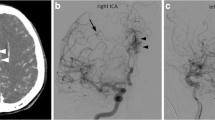Abstract
Whether antithrombotic treatment is safe and/or affects the risk of intracranial bleeding in subjects with sporadic brain arteriovenous malformations (AVMs) is unknown. We conducted a retrospective analysis on the use of antithrombotics among patients affected by brain AVMs in follow-up at our institution. Attention was paid to the type of antithrombotic drug (either antiplatelets or anticoagulants), current or past use, dosage, and duration of treatment. Several clinical and angioarchitectural features of brain AVMs were also taken into consideration. The association between the use of antithrombotics and haemorrhagic onset was analyzed. A total of 77 patients were included in this study. Among them, ten patients were taking antithrombotic drugs at the time of AVM diagnosis. The rate of haemorrhagic onset was not significantly different between subjects who were and were not taking antithrombotic drugs (40 vs 55.2%, p = ns). Among the many clinical and angioarchitectural features analyzed, the only parameter that showed a statistically significant association with haemorrhagic onset was the size of the nidus. Patients who took antithrombotic treatments after being diagnosed with a brain AVM did not show an increased rate of intracranial haemorrhage over time considering a mean follow-up 4 years. In our study, antithrombotic treatment was not associated with increased intracranial bleeding among subjects with brain AVMs. In the presence of a strong clinical indication, antiplatelet and anticoagulant medications should not be denied a priori to patients with brain AVMs. Studies on larger populations are necessary to confirm these data.
Similar content being viewed by others
References
Stapf C, Labovitz DL, Sciacca RR, Mast H, Mohr JP, Sacco RL (2002) Incidence of adult brain arteriovenous malformation haemorrhage in a prospective population-based stroke survey. Cerebrovasc Dis 13:43–46
Hillman J (2001) Population-based analysis of arteriovenous malformation treatment. J Neurosurg 95:633–637
Sturiale CL, Puca A, Calandrelli R, D’Arrigo S, Albanese A, Marchese E, Alexandre A, Colosimo C, Maira G (2013) Relevance of bleeding pattern on clinical appearance and outcome in patients with haemorrhagic brain arteriovenous malformations. J Neurol Sci 324:118–123
Gross BA, Du R (2013) Natural history of cerebral arteriovenous malformations: a meta-analysis. J Neurosurg 118:437–443
Fok EW, Poon WL, Tse KS, Lau HY, Chan CH, Pan NY, Cho HY, Yeung TW, Wong YC, Leung KW, Khoo JL, Tang KW (2015) Angiographic factors associated with haemorrhagic presentation of brain arteriovenous malformation in a Chinese paediatric population. Hong Kong Med J 21:401–406
Mohr JP, Parides MK, Stapf C, Moquete E, Moy CS, Overbey JR, Al-Shahi Salman R, Vicaut E, Young WL, Houdart E, Cordonnier C, Stefani MA, Hartmann A, von Kummer R, Biondi A, Berkefeld J, Klijn CJ, Harkness K, Libman R, Barreau X, Moskowitz AJ, International ARUBA investigators (2014) Medical management with or without interventional therapy for unruptured brain arteriovenous malformations (ARUBA): a multicentre, non-blinded, randomised trial. Lancet 383:614–621
Wiebers DO, Whisnant JP, Huston J 3rd, Meissner I, Brown RD Jr, Piepgras DG, Forbes GS, Thielen K, Nichols D, O’Fallon WM, Peacock J, Jaeger L, Kassell NF, Kongable-Beckman GL, Torner JC, International Study of Unruptured Intracranial Aneurysms Investigators (2003) Unruptured intracranial aneurysms: natural history, clinical outcome, and risks of surgical and endovascular treatment. Lancet 362:103–110
Dasenbrock HH, Yan SC, Gross BA, Guttieres D, Gormley WB, Frerichs KU, Ali Aziz-Sultan M, Du R (2017) The impact of aspirin and anticoagulant usage on outcomes after aneurysmal subarachnoid haemorrhage: a Nationwide Inpatient Sample analysis. J Neurosurg 126:537–547
Garbe E, Kreisel SH, Behr S (2013) Risk of subarachnoid haemorrhage and early case fatality associated with outpatient antithrombotic drug use. Stroke 44:2422–2426
Gross BA, Rosalind Lai PM, Frerichs KU, Du R (2014) Aspirin and aneurysmal subarachnoid haemorrhage. World Neurosurg 82:1127–1130
Hasan DM, Mahaney KB, Brown RD Jr, Meissner I, Piepgras DG, Huston J et al (2011) Aspirin as a promising agent for decreasing incidence of cerebral aneurysm rupture. Stroke 42:3156–3162
Chyatte D, Bruno G, Desai S, Todor DR (1999) Inflammation and intracranial aneurysms. Neurosurgery 45:1137–1147
Sturiale CL, Puca A, Sebastiani P, Gatto I, Albanese A, Di Rocco C, Maira G, Pola R (2013) Single nucleotide polymorphisms associated with sporadic brain arteriovenous malformations: where do we stand? Brain 136:665–681
Chick JF, Sheehan SE, Chauhan NR (2012) The many faces of Hereditary Hemorrhagic Telangiectasia: median arcuate ligament syndrome, arteriovenous malformations, and cerebral aneurysms. Intern Emerg Med 7:385–386
Edwards CP, Shehata N, Faughnan ME (2012) Hereditary haemorrhagic telangiectasia patients can tolerate anticoagulation. Ann Hematol 91:1959–1968
Devlin HL, Hosman AE, Shovlin CL (2013) Antiplatelet and anticoagulant agents in hereditary haemorrhagic telangiectasia. N Engl J Med 368:876–878
Brinjikji W, Iyer VN, Wood CP, Lanzino G (2017) Prevalence and characteristics of brain arteriovenous malformations in hereditary haemorrhagic telangiectasia: a systematic review and meta-analysis. J Neurosurg 127:302–310
Verdecchia P, Angeli F, Aita A, Bartolini C, Reboldi G (2016) Why switch from warfarin to NOACs? Intern Emerg Med 11:289–293
Author information
Authors and Affiliations
Consortia
Contributions
All authors have read and approved the submitted manuscript; it has not been submitted elsewhere nor published elsewhere in whole or in part. There are no competing interests.
Corresponding author
Ethics declarations
Conflict of interest
The authors declare that they have no conflict of interest.
Statement of human and animal rights
The protocol was conducted in agreement with the Helsinki declaration. This dataset is completely anonymous and does not contain any identifiable personal data.
Informed consent
Informed consent was obtained from all individual participants included in the study at the time of their hospital admission.
Rights and permissions
About this article
Cite this article
Sturiale, C.L., Pignotti, F., Giordano, M. et al. Antithrombotic therapy and intracranial bleeding in subjects with sporadic brain arteriovenous malformations: preliminary results from a retrospective study. Intern Emerg Med 13, 1227–1232 (2018). https://doi.org/10.1007/s11739-018-1918-7
Received:
Accepted:
Published:
Issue Date:
DOI: https://doi.org/10.1007/s11739-018-1918-7




